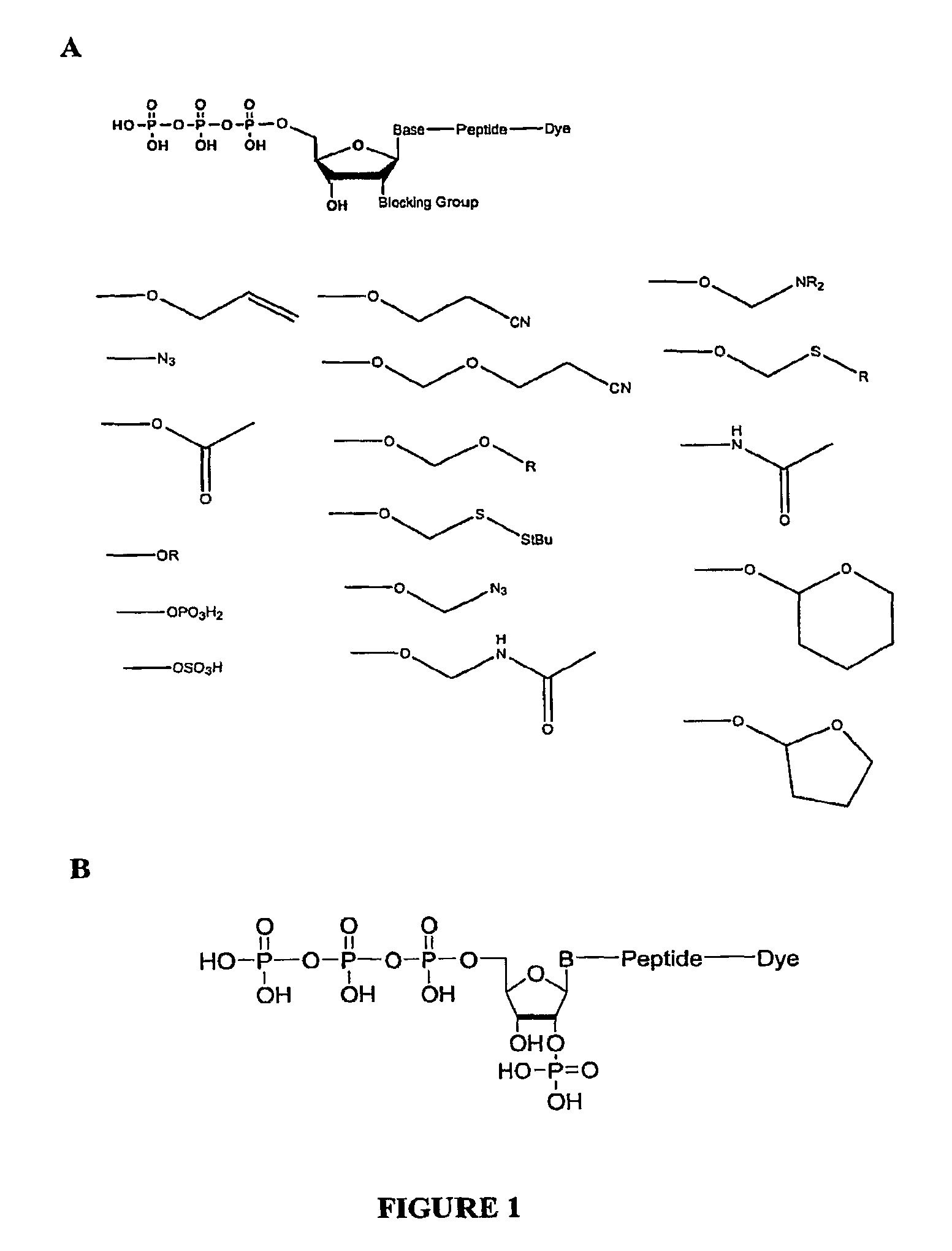Compositions and methods for nucleotide sequencing
a technology of nucleotide sequence and composition, applied in the field of nucleic acid analysis methods, can solve the problems of limited methodology, slow and painstaking progress of advancement, and few guarantees that the threshold needed to translate a discovery into a practical medical application has been achieved
- Summary
- Abstract
- Description
- Claims
- Application Information
AI Technical Summary
Benefits of technology
Problems solved by technology
Method used
Image
Examples
example i
Synthesis of Nucleotides
[0165]This example describes the synthesis of exemplary nucleotides useful in the invention.
[0166]An exemplary 2′ reversible terminator with a phosphate group at the 2′ position was synthesized, as shown in FIG. 1B. Synthesis of various nucleotides is described in more detail below.
Synthesis of 2′-Phosphate UTP.
[0167]For synthesis of 2′-phospho UTP, 100 mg of 3′phosphate CPG (Glen Research), 43 umol / g, was placed into a 3 ml fritted syringe. The syringe was washed 3 times with 3% trichloroacetic acid / dichloromethane (TCA / DCM) solution, 2 min, followed by washing 6 times with 2 ml acetonitrile. A volume of 1.5 ml of 0.1M solution of 5′-DMT-3′-tBDsilyl-ribo uridine CED phorphoramidite (Catalog No. ANP-5674, ChemGenes; Wilmington Mass.) in acetonitrile was mixed with 1.5 ml of 0.25 M 4,5-dicyanoimidazole (DCI) in acetonitrile and added to the reaction vessel. The reaction was carried out for 10 min. The syringe was washed with 2 ml acetonitrile, and the reaction...
example ii
Enzymatic Removal of a Blocking Group from a Reversible Terminator
[0173]This example describes removal of a blocking group from an exemplary 2′ reversible terminator.
[0174]A 2′ reversible terminator having a phosphate blocking group at the 2′ position, as shown in FIG. 1B, was used. The 2′ reversible terminator was incubated with alkaline phosphatase. The results show that the phosphate group can be quantitatively removed using alkaline phosphatase in less than one minute in aqueous buffer at room temperature. Briefly, 2′ reversible terminator ribonucleotide was incorporated into a 15-mer primer, annealed to a 42-mer template oligonucleotide, and phosphate removed in the duplex by incubation with calf intestinal alkaline phosphatase (2 mU / μl; USB) for 10 minutes at 37° C.
example iii
Identification and Optimization of Enzymatically Cleavable Peptide Linkers
[0175]This example describes the identification of exemplary peptide linkers cleavable by proteases.
[0176]Peptide synthesis can be carried out using standard Fmoc solid phase peptide synthesis. After synthesis, the peptides were cleaved from the support and the protecting groups removed using 95% TFA with scavengers. The peptides were then precipitated with ethyl ether, washed and dried. The peptides were then dissolved in an appropriate solvent and analyzed by HPLC and mass spectroscopy for quality analysis.
[0177]Cleavage data has been generated for 1000 different peptides for subtilisin A, chymotrypsin and proteinase K. Cleavage of a set of exemplary peptides is shown in FIG. 3. Assays were carried out essentially as described previously in U.S. publication 2006 / 0216721, which is incorporated herein by reference.
[0178]Among the 10 peptide sequences, one peptide was selected for further optimization to reduce...
PUM
| Property | Measurement | Unit |
|---|---|---|
| pH | aaaaa | aaaaa |
| temperature | aaaaa | aaaaa |
| Tm | aaaaa | aaaaa |
Abstract
Description
Claims
Application Information
 Login to View More
Login to View More - R&D
- Intellectual Property
- Life Sciences
- Materials
- Tech Scout
- Unparalleled Data Quality
- Higher Quality Content
- 60% Fewer Hallucinations
Browse by: Latest US Patents, China's latest patents, Technical Efficacy Thesaurus, Application Domain, Technology Topic, Popular Technical Reports.
© 2025 PatSnap. All rights reserved.Legal|Privacy policy|Modern Slavery Act Transparency Statement|Sitemap|About US| Contact US: help@patsnap.com



